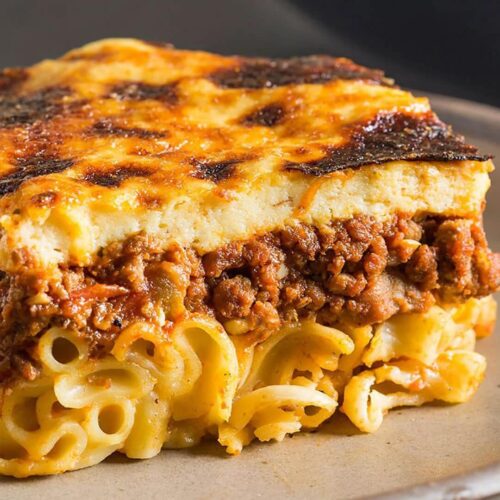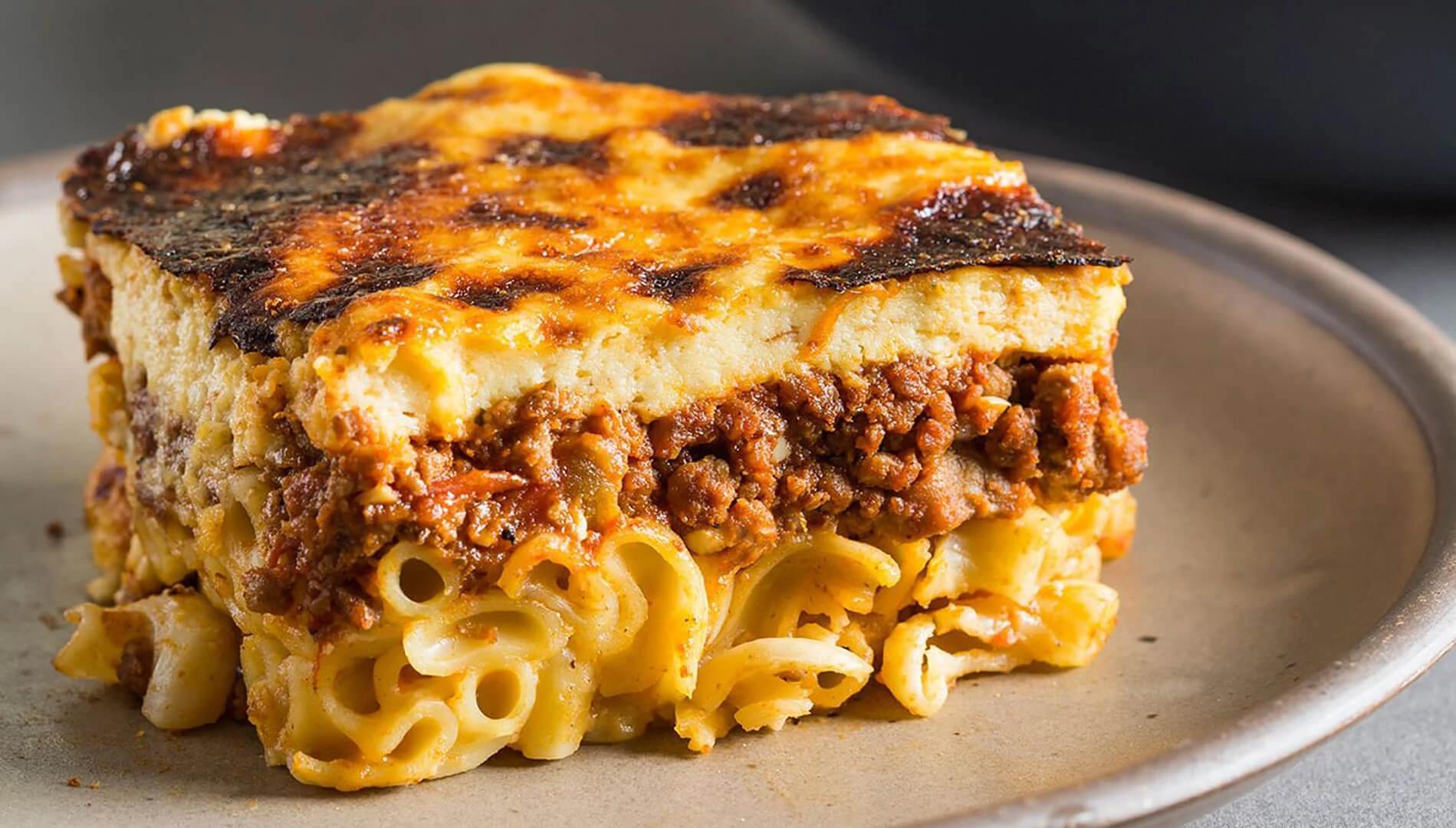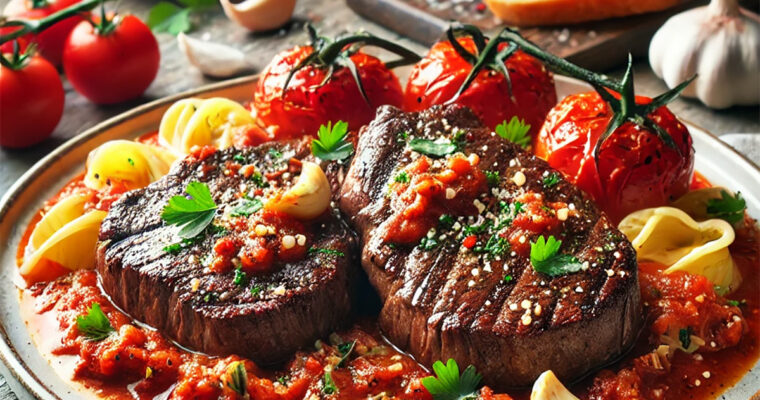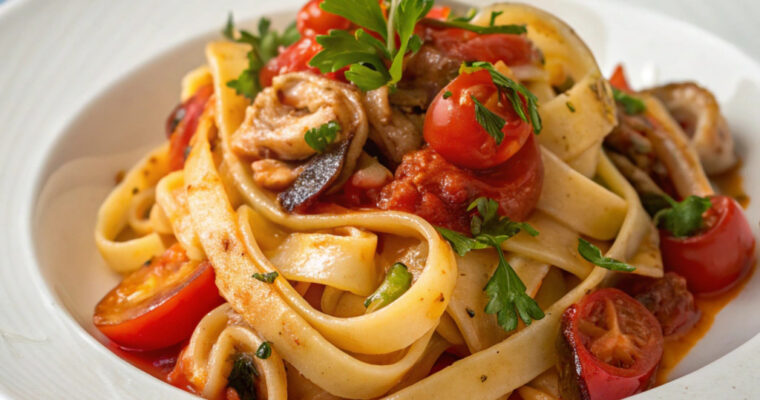Today, we’re going to take a gastronomic tour into the heart of Greece, where each dish reveals a little of history, coziness, and the love of family get-togethers. Come along as we discover the mouthwatering tastes and fascinating background of pastitsio, one of Greece’s most popular delicacies.
Before we dive into the recipe, let’s savor a taste of the past. Greek pastitsio, pronounced “pah-STEE-tsee-oh,” is a staple of Greek cooking. Loved for many years as a representation of delicious home-cooked food. Where creative chefs prepared filling dishes to celebrate the small joys in life and to feed their family.
Baked to golden perfection, this dish embodies the essence of Greek comfort cuisine, a harmonic combination of pasta, savory meat sauce, creamy béchamel, and aromatic spices. Its name, which reflects its complex and decadent character, comes from the Italian term “pasticcio,” which means pie or mess.
Pastitsio has changed over time, with each Greek area contributing a distinctive touch. But fundamentally, it continues to be a celebration of the joy of dining with loved ones and the enduring appeal of Mediterranean cuisine.
Origin of Pastitio
While the precise history of pastitsio remains unknown, its essence captures the essence of Greek hospitality and culinary artistry. Venetian tradesmen brought lasagna from Italy to Greece during the Byzantine era, according to some. Some credit the Ottoman influence for its origin, as Greek food incorporated layers of spices and fragrant plants.
Whatever its origins, pastitsio has made a name for itself in Greek society, appearing on tables for festivals, celebrations, and casual get-togethers. Every taste of it is a celebration of life’s small joys, and its reassuring perfume fills homes with nostalgia and sends diners to a world where time stops still.
What is pastitio?
The simplest way to describe what is Pastitsio is a greek version of Lasagna. Traditional pastitsio recipe has three layers:
- First layer has a deep layer of tubular pasta.
- Second layer has a delicious meaty sauce.
- The final layer has a creamy béchamel sauce.
Pastitsio utilizes cylindrical tubes of pasta bucatini pasta or #2 Pasta, allowing for a much thicker pasta layer. Italian lasagna traditionally incorporates ricotta and mozzarella cheeses, both made of buffalo’s or more commonly cow’s milk. Below I describe the two types of cheese to make pastitsio either Kefalotyri or Graviera cheese.
GRAVIERA CHEESE

“Graviera is Greece’s second most popular cheese after Feta. The very first Graviera was produced in the country in 1914 by a cheesemaker in the Peloponnese and was based on the recipe of the Swiss Gruyère cheese (even the name itself, Graviera, is somewhat derived from Gruyère), but with one significant difference: cow’s milk was replaced by sheep and goat’s milk.
Since then, the recipe has evolved and was amended, while cow’s milk was also used for certain types of the cheese, so that nowadays Greek Gravieras have no connection whatsoever with the original Swiss version.
There are three PDO Gravieras in Greece: Graviera Agrafon (produced in Western Thessaly and Evritania), Graviera Kritis (produced in Crete) and Graviera Naxou (from the island of Naxos in the Cyclades). Production of exceptional Graviera cheese –although not registered as PDO– also takes place in the islands of Tinos (from cow’s milk), Lesvos, as well as in the region of Epirus and the municipality of Amfilochia. In conclusion, Graviera is a cheese with a big “personality” and a great variety –from sweet to very spicy– to fit every taste.” Excerpt from Ambrosia Magazine
KEFALOTYRI CHEESE

“Kefalotyri or kefalotiri is a traditional cheese made from sheep milk and/or goat’s milk in Greece and Cyprus, dating back to the Byzantine era. It is a hard, light-yellow cheese with a sharp flavour and dry texture. The colour varies from yellow to white depending upon the mixture of milk used. Young cheeses are aged for a minimum of two to three months, whereas aged Kefalotyri can be a year old or more with a dry, stronger flavour. Kefalotyri tastes similar to Gruyere; however, it is harder and saltier. The cheese is consumed as is or used in pasta, meat and cooked vegetable dishes. It is also traditionally served fried in strips or cubes for a dish called saganaki. Ideal for cheeseboards, the tangy cheese is served with fresh seasonal fruit, such as pears, figs and grapes, alongside red wine and sausages.” Excerpt from cheese,com
WHAT INGREDIENTS YOU NEED TO MAKE PASTITSIO
- #2 Pasta or substitute
- Graviera or Kefalotyri cheese
- Mince Meat
- Red or White Onions
- Garlic
- Tomato Passata
- Various herbs and spices
- Olive Oil
- Butter
- Flour
- Eggs
- Milk
As the aroma of freshly baked pastitsio fills your kitchen. Take a moment to appreciate the simple joys of good food and shared memories. This timeless Greek classic is sure to warm your heart and nourish your soul. The effort required to prepare this iconic dish for the family or savored solo is well worth it. This is the ultimate Greek comfort food, along with the legendary traditional Greek Moussaka of course! So grab your loved ones, lift your glasses, and enjoy every mouthwatering morsel of this delectable comfort dish.

Pastitsio
Ingredients
Base
- 450 gr #2 pasta or bucatini pasta, penne or ziti uncooked
- 4 tbsp butter (not salted)
- 2 egg whites
- 1/4 cup kefalotyri cheese
Meat Sauce
- 900 grams lean ground beef
- 1 medium sized red onions (finely chopped)
- 1 cloves of garlic (finely chopped)
- 650 grams tomato passata
- 2 tbsp tomato paste
- 1/2 tsp cinnamon
- 1/4 tsp ground cloves
- 1/4 tsp allspice (bahari)
- 1 tsp oregano
- 1 bay leaf
- 4 tbsp olive oil
- 1/2 cup red wine
- 1 tsp salt and pepper (to taste)
Beschemel Sauce
- 1200 ml milk 1.2 liters
- 4 egg yolks
- 2 egg whites
- 120 grams butter (not salted)
- 120 grams plain flour
- 1/2 cup kefalotyri cheese
- 1/4 tsp nutmeg
Instructions
Meat Sauce
- Place the 3 tbsp of olive oil into pot and set to high heat.
- Sautee meat until brown, approx 15 minutes. Make sure all moisture has evaporated before adding onion and garlic.
- Add in the onion and garlic, sautee about 5 minutes.
- Add the tomato paste and cook for about 2 -3 minutes.
- Deglaze by adding in the red wine, let the alcohol content evaporate.
- Add in the spices and tomato sauce, stir well.
- Bring to a simmer and allow to cook about 40 minutes.
Base
- Cook the pasta 3 minutes before fully cooked.
- After cooking them, drain and place pasta aside.
- Add 4 tblsp of butter (not salted) and mix well.
- ¼ cup of kefalotyri and set aside.
- Beat egg whites and set aside.
Beschemel Sauce
- Place pot on low-medium heat and add the butter.
- Melt the butter until bubbles form on top, do not allow to get too hot.
- Add in the flour all at once.
- Stir continuously, do not let the butter burn, but bring the mixture to a golden, nutty color, about 2-3 minutes.
- Lower the heat, slowly add in the milk while stirring with a whisk to avoid lumps. Mix into a creamy sauce and bring to a low boil.
- Add the kefalotyri and the nutmeg, salt and white pepper and mix well.
- Once it is bubbling take pot off the heat.
- Add in the egg yolks and mix thoroughly and carefully.
Asembling your Pastitsio
- In an oiled baking dish (25 by 32cm or 9 by 13in) assemble your pastitsio.
- Use the egg whites, and kefalotyri cheese, and mix well into the pasta.
- Add the pasta evenly in the pan.
- Add the meat sauce into the pan and spread evenly over the pasta.
- Add bechamel on top and spread evenly.
- Sprinkle ¼ cup kefalotyri on top of the sauce and place into oven.
- Cooking time 45 minutes to 1 hour or until golden brown at 180 – 200 c or 350 – 380 f.
Notes
- Pasta should never be fully cooked because it will become mush in the pan while baking. It will cook itself in the pan and will come out perfect.
- An old school cook told me once to combine the egg whites with the pasta to ensure the pasta doesn’t break apart when you cut out a piece from the pan when cooked.
- This recipe is an old tried and true recipe. I have used it in my deli business years ago and it was very successful. Try it and you’ll like it!






Hello! I simply would like to offer you a huge thumbs up for the great information you have right here on this post. I will be coming back to your blog for more soon.